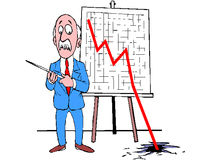1.6 External Growth
What we will study?

By the end of this unit you should be able to:
- Analyse the main types of economies and diseconomies of scale and apply these concepts to business decisions
- Evaluate the relative merits of small versus large organisations
- Explain the difference between internal and external growth
- Analyse the advantages and disadvantages of franchising and evaluate it as a growth strategy
- Evaluate internal and external growth strategies as methods of expansion
- Discuss the impact of globalisation on business growth
- Explain reasons for the growth of multinational companies
- Evaluate the impact of multinational companies on host countries
Economies of scale
The advantages of large scale production that result in lower unit (average) costs (cost per unit)
|
| ||||
Economies of scale can affect all aspects of a business. McDonald’s 14,098 locations dwarf the next closest hamburger chain Wendy’s 5,876 locations. Assuming each chain spends the same amount per location on advertising, McDonald’s spends triple the amount Wendy’s does promoting its burgers. This marketing economy of scale serves McDonald’s in several ways.
First, the average person sees a McDonald’s ad three times more often than a Wendy’s ad, which should lead to greater sales. Second, McDonald’s has more locations at which to purchase hamburgers, so the advertising has a greater chance of pulling a consumer into a McDonald’s. Third, the large marketing expenditure created by combining 14,000 locations creates a massive moat protecting McDonald’s from competition.
The industrial revolution is over, and gone with it is some of the power of economies of scale. Today, businesses of all sizes can compete with large multinational corporations, particularly on the Internet. The Internet acts as a great equalizer, allowing small companies access to business resources previously reserved for large companies. The Internet allows businesses to
When Amazon.com was launched, Jeff Bezos was operating out of his garage. Today Amazon boasts sales in excess of $50 million annually. Google was a school project of Serge Brin and Larry Page. Mark Zuckerberg was horsing around when he created Facebook in his dorm room. Some of today’s largest and most profitable businesses started as tiny ventures that have expanded through skillful use of the Internet.
First, the average person sees a McDonald’s ad three times more often than a Wendy’s ad, which should lead to greater sales. Second, McDonald’s has more locations at which to purchase hamburgers, so the advertising has a greater chance of pulling a consumer into a McDonald’s. Third, the large marketing expenditure created by combining 14,000 locations creates a massive moat protecting McDonald’s from competition.
The industrial revolution is over, and gone with it is some of the power of economies of scale. Today, businesses of all sizes can compete with large multinational corporations, particularly on the Internet. The Internet acts as a great equalizer, allowing small companies access to business resources previously reserved for large companies. The Internet allows businesses to
- Reach customers all around the world without the expense of a physical outlet.
- Market products very inexpensively.
- Attack previously unprofitable, tiny niche markets.
- Access vendors and talent from around the world.
- Operate virtual offices, eliminating the need for expensive overhead.
- Teleconference and videoconference for little or no money, eliminating the need for expensive travel.
When Amazon.com was launched, Jeff Bezos was operating out of his garage. Today Amazon boasts sales in excess of $50 million annually. Google was a school project of Serge Brin and Larry Page. Mark Zuckerberg was horsing around when he created Facebook in his dorm room. Some of today’s largest and most profitable businesses started as tiny ventures that have expanded through skillful use of the Internet.
What is a multinational corporation?
IMPORTANT NOTE: A conglomerate is a combination of two or more corporations engaged in entirely different businesses that fall under one corporate group.
|
A corporation that has its facilities and other assets in at least two countries other than its home country. Such companies have offices and/or factories in different countries and usually have a centralized head office where they co-ordinate global management. Very large multinationals have budgets that exceed those of many small countries. Nearly all major multinationals are either American, Japanese or Western European, such as Nike, Coca-Cola, Wal-Mart, AOL, Toshiba, Honda and BMW. Advocates of multinationals say they create jobs and wealth and improve technology in countries that are in need of such development. On the other hand, critics say multinationals can have undue political influence over governments, can exploit developing nations as well as create job losses in their own home countries.
|
|

